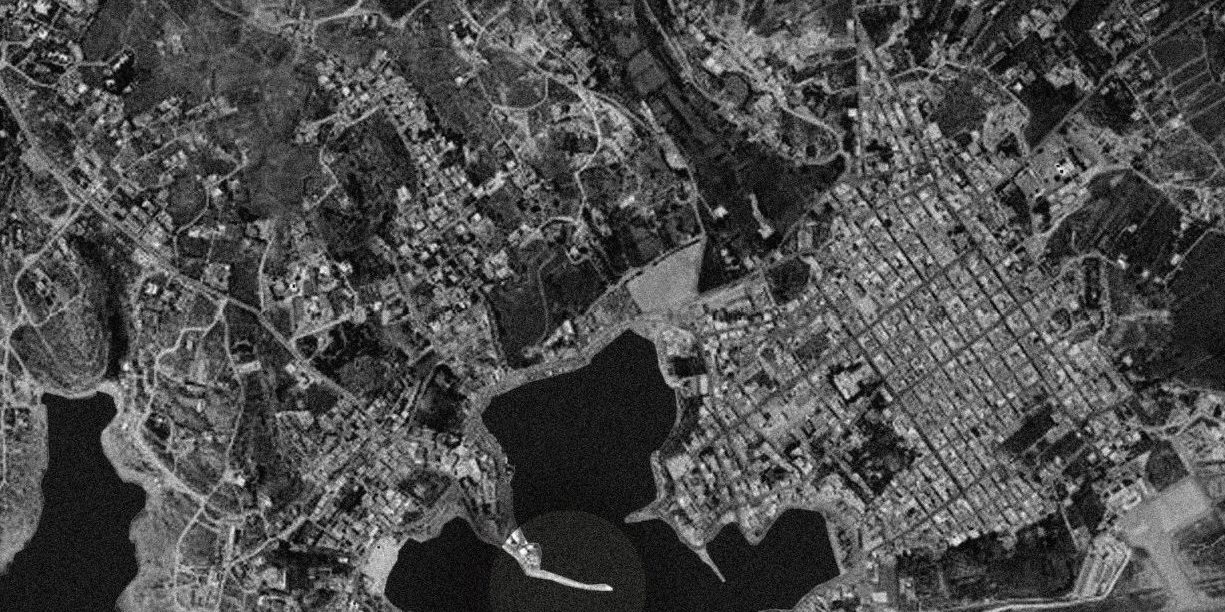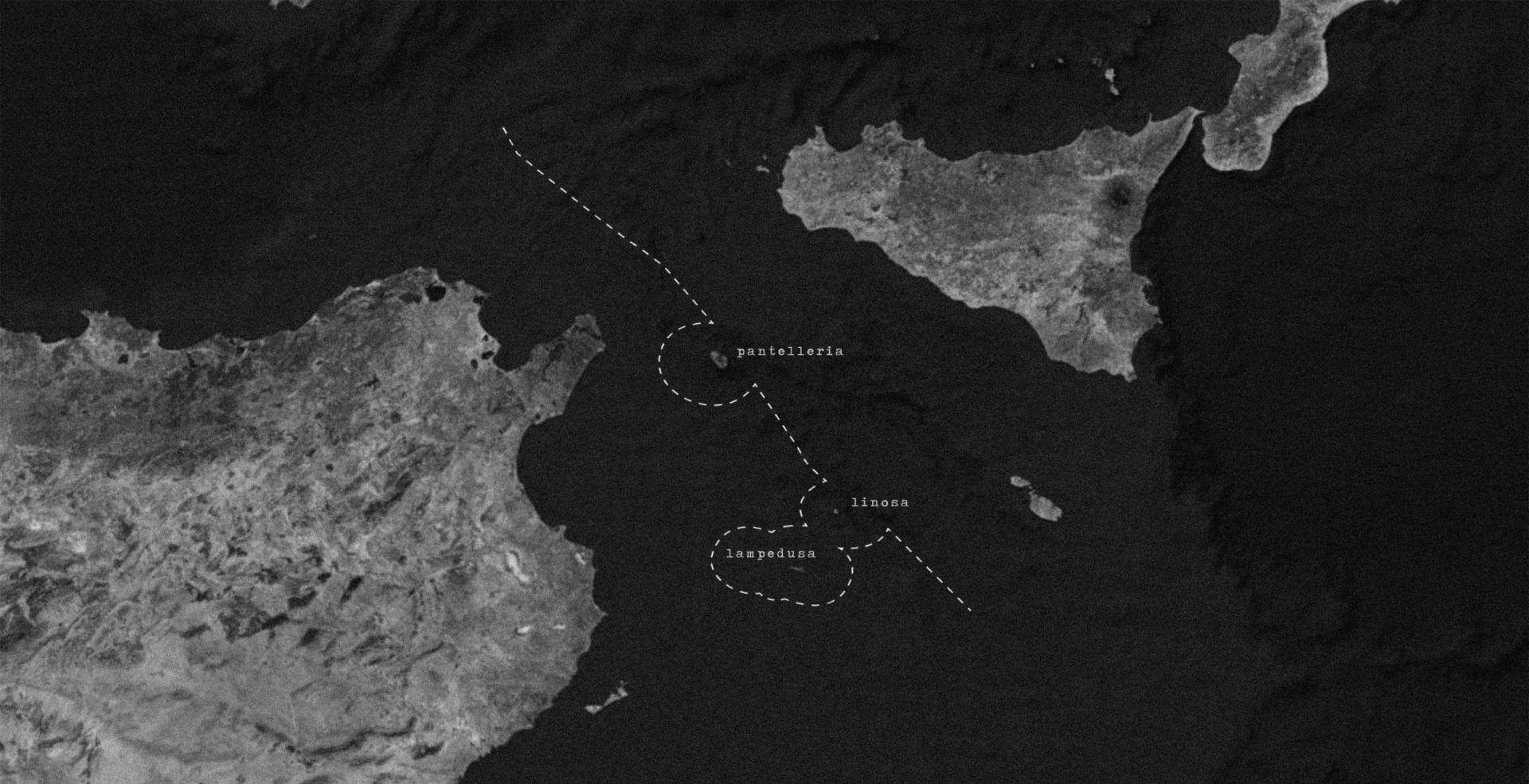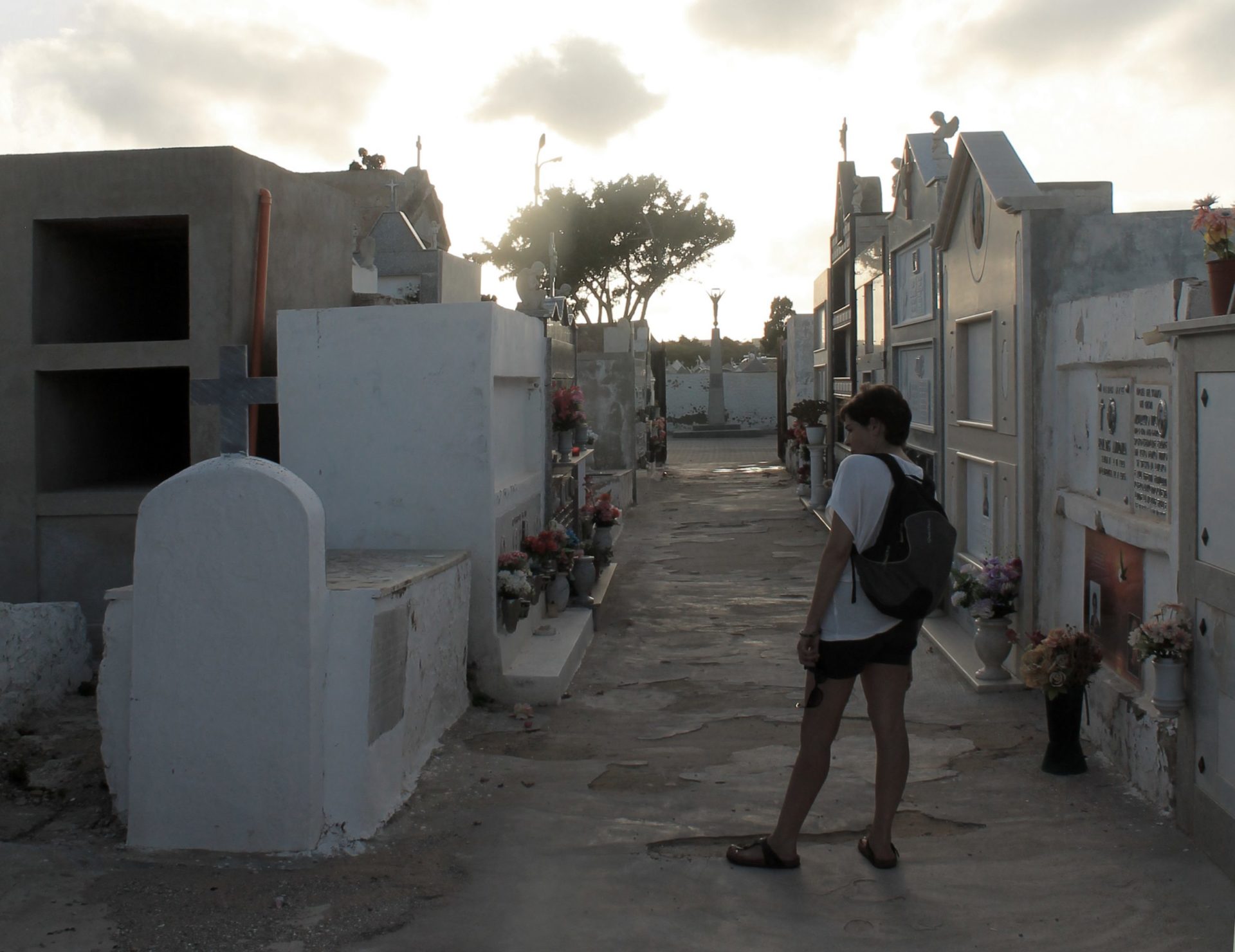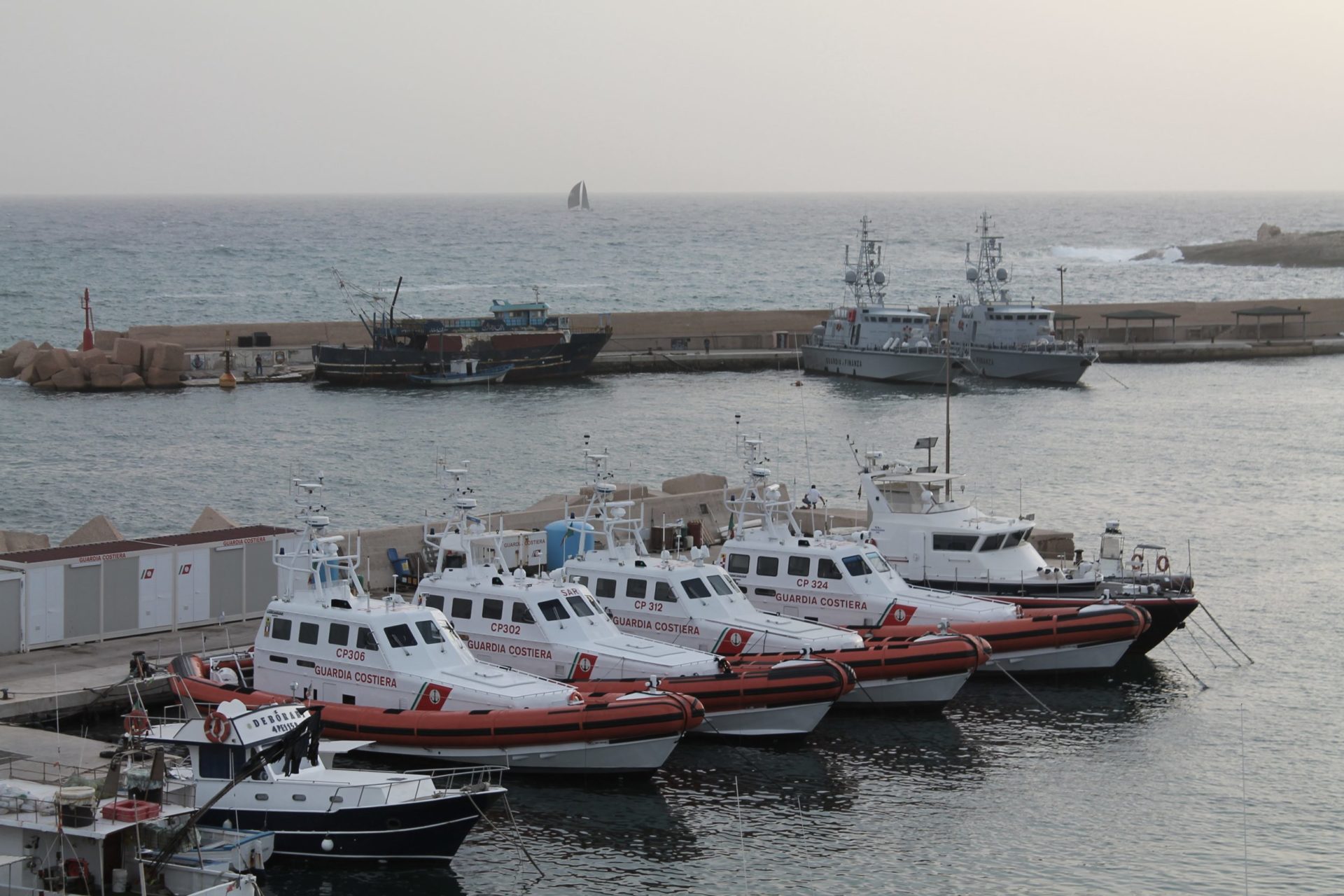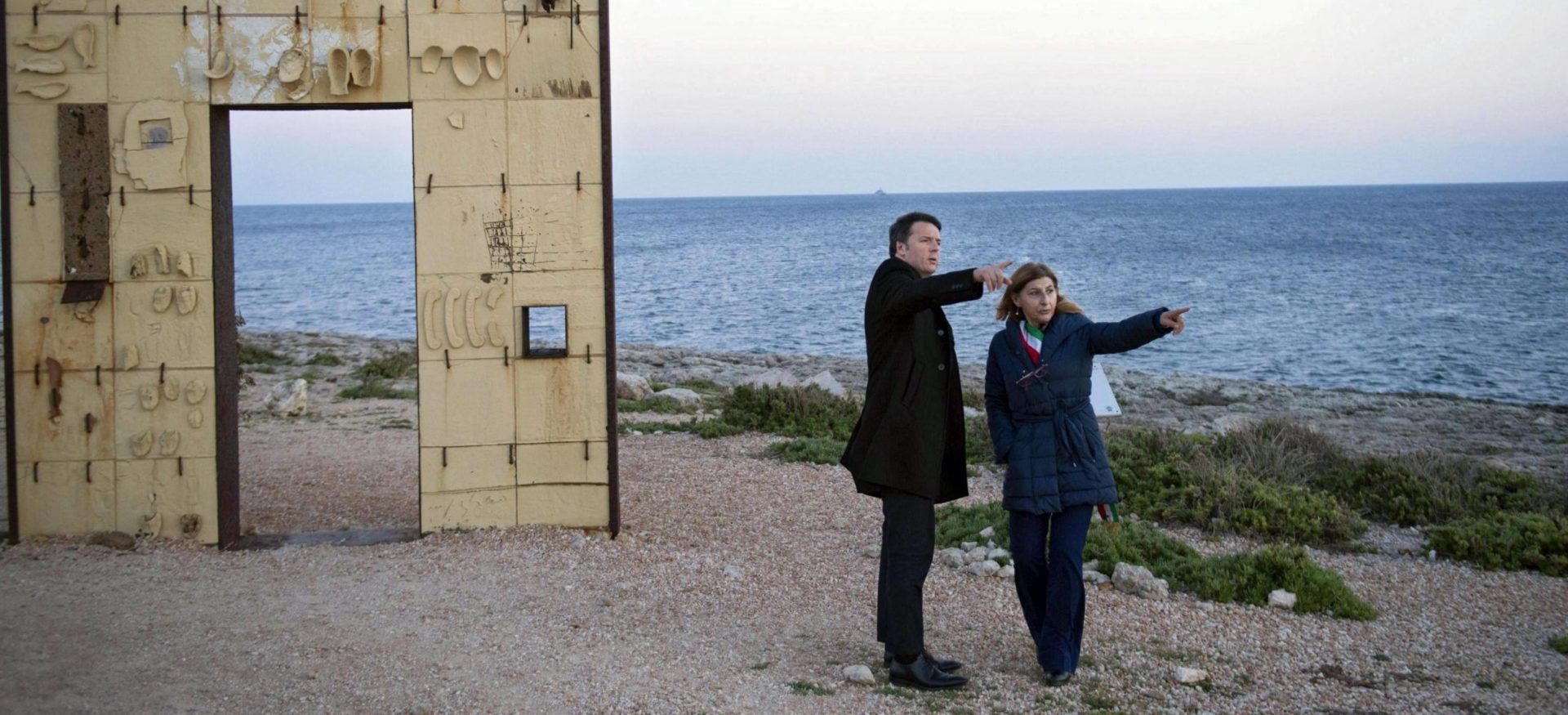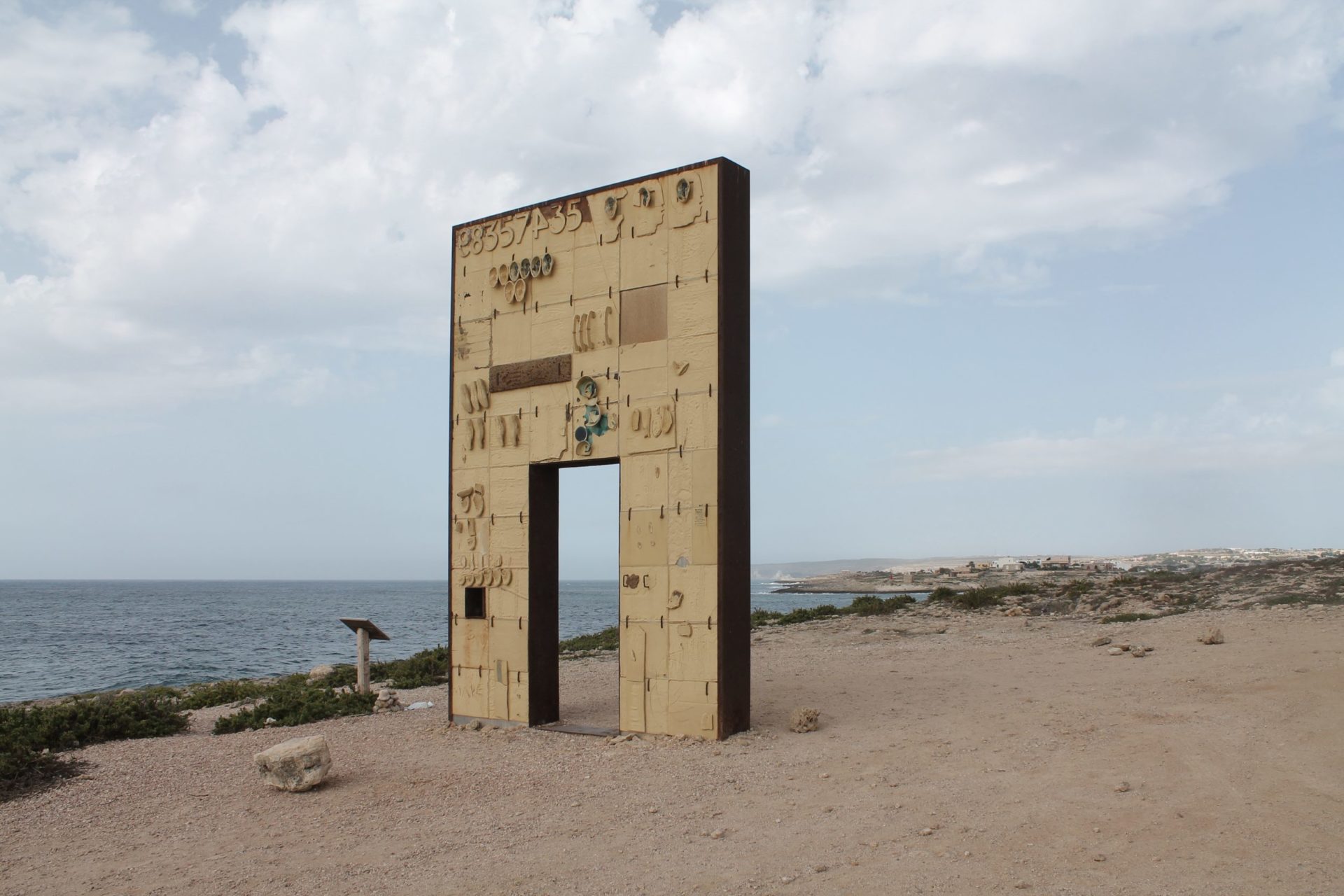Two people are standing by a beaten-up Toyota on an arid, scrub-covered hilltop in the middle of nowhere. They are looking at the valley, keeping a safe distance from the edge. They have to make sure they are not visible from down there, to avoid any trouble. From where they stand, they can see only the roofs of the buildings at the bottom of the valley, some red and white prefabs making their way out of the green vegetation. Getting closer to the edge, they can probably see people walking between the buildings, hanging clothes out to dry on their fences, maybe playing football or talking outside. We’ve all seen these scenes on TV. But they can’t get any closer, otherwise the soldiers might confiscate their cameras. Instead, they will just take nice pictures of the valley, the prickly pears and the scattered agaves lining the hillsides. Even of the sea, in the background.
The migrants detention center of the island of Lampedusa is not accessible to the public, since the only street that reaches the valley is blocked by the military a few hundred meters before the gate. Hidden in the valley and covered by vegetation, the location of the center seems to deliberately convey the message: “Do not enter. Do not look. Mind your own business”. You will certainly not stumble upon it while walking on the island, and most likely, the only images you will ever see are the ones accurately staged for the purpose of propaganda. In general, an analysis of the island of Lampedusa reveals that most of the areas where migrants are hosted are either hidden or fenced off, unless there are political reasons to display them. In the latter case, the media convey an image of these places that is instrumental to these political reasons.
The identity of Lampedusa, a small island in the middle of the Mediterranean Sea, is nowadays almost exclusively associated with the phenomenon of migration from Africa and, as a result, with the presence of the border between the African and European continents. Borders dominate the social and political debate about migration in Europe, and they profoundly affect the image of the island in the eyes of inhabitants and visitors alike.
Our current notion of international borders is relatively new. Up until World War II, the frequency with which international borders were changed was much higher. The unprecedented period of peace that followed the war made them, in reality, and in people’s perception, much less fluid and subject to change. The passport, which is today considered a necessary tool to regulate the movement of people, was introduced only after World War I as a temporary measure, and it was never removed thereafter.
Borders have become so dominant in our way of perceiving the world that we tend to forget they are man-made, arbitrary lines, and that they often do not correspond to perceptible discontinuities. Even when they are the manifestation of natural or ethnic boundaries, borderlines per se remain artificial, and they only persist if they are sufficiently enforced by the governments that have a vested interest in them.
The increasing tendency to enforce borders through the construction of physical walls highlights both how much borders can be (ab)used to restrict freedom of movement for certain categories of people, and how often they are used to influence the public’s opinion about topics of immigration and national security. The wall between the United States and Mexico is a glaring example of how a barrier is often just a theatrical, political display. As Marcello Di Cintio explains in his book Walls, “Raw steel bars make for good theatre and look impressive on television newscast, but they are easily defeated”.
Yet, not every border materializes through a wall. This is most evidently the case of international sea borders. The borderline between Italy and Tunisia, for instance, sits approximately halfway between the coastlines of Africa and Sicily, as it was drawn without consideration for the presence of four Italian islands—Lampedusa, Linosa, Lampione, and Pantelleria. As a result, the territorial waters of these islands fall completely in the Tunisian sea. The consequences of such an invisible border may even reach further than those of a man-made obstacle. The case of Lampedusa shows that a border does not always require a wall to be enforced. The island’s geographical characteristics created the perfect conditions to ‘spectacularize’ the border without building an artificial barrier.
As explained by Paolo Cuttitta, a researcher investigating the implications of European border narratives, “the geographical context alone would not suffice to explain why Lampedusa is more ‘border’ not only than other sea border spots in Calabria or Sicily, but also more than Pantelleria, another Italian island just off the coast of Sicily, which is even closer to North Africa.” He argues that Lampedusa was deliberately turned into a border place: yearly data on the arrival of migrants to Lampedusa, to Sicily, and to the rest of Italy, suggests that the episodes of overcrowding of the island’s detention center were not a consequence of a greater number of arrivals overall, but of the fact that most of these migrants were intentionally diverted to Lampedusa and held there instead of being transferred to the mainland. The diplomacy between Italy and its cross-Mediterranean neighbors, particularly Libya, often caused migrants’ flows to be manipulated so as to influence political choices. For example, in the early 2000s, Libyan leader Muammar Gadhafi deliberately eased control over the Libyan coastline to gain bargaining power in his collaboration with Italy to curb illegal departures. What seemed to be emergencies were thus simply the artifact of political machination.
At first glance, the landscape of the island reveals that the increasingly burdensome presence of the border left its mark on the territory. Many areas are cut off from public access, restricted for military purposes or simply affected by dilapidation. The barracks of the different law enforcement organizations, together with their sea and land vehicles, are one of the most recurring visual elements. The local cemetery, a place of commemoration and mourning, became a symbolic battlefield to protest against the anonymity of the mass graves. Here, socially and politically active tourists are told the stories of those who died trying to reach the island of Lampedusa.
But the territory of the island is not simply subject to the consequences of the border. In order to maintain the current state of affairs, over the years it has also acquired a very active role in creating this border spectacle. This shift has been achieved via the tools of urbanism, architecture, and art. As a result, it is now possible to look at the urban landscape of Lampedusa for evidence that can illustrate the process through which a border is produced.
C.P.S.A.
The Centro di Primo Soccorso e Accoglienza, literally First Aid and Reception Center is the only detention center for migrants on a minor Italian island. The presence of the center, established in 1996, is in fact what allows the redirection to Lampedusa of a great number of migrants rescued in the Mediterranean. Its construction was, therefore, the first (and most crucial) step in turning the island into a grand theater for the border.
The choice to place the CPSA in a hidden valley and make it inaccessible to the public, as mentioned before, seems to have the aim of creating as big a distance as possible between the people living and working on Lampedusa and the migrants forcibly held on it. The isolation of the center affects the narrative surrounding the island in several ways. As it was shown by the frequency of riots and violence, especially during periods of overcrowding, the isolation tends to escalate frustration and resentment among the people locked in the center, by alienating them from any semblance of normal life. The isolated position is also very convenient: it makes the place ideal to tell a story that cannot be contested by witnesses, exacerbating the feeling of detachment—which is, at any rate, always part of island life. To complete the picture, the physical barrier of the fence—which the media invariably depicts the migrants standing behind—widens the conceptual distance between ‘us’ and ‘them’, the ‘invaded’ and the ‘invaders’.
Molo Favaloro
After being rescued at sea, the migrants are usually disembarked at the Molo Favaloro, the military pier. Publicly inaccessible yet perfectly visible from the other side of the bay, the pier is where the boats of the Coast Guard and other branches of the military are docked. The proliferation of military boats on the pier signaled the shift from a pattern of spontaneous and occasional arrivals of migrants in the early-90s, to the well-oiled immigration machine put in place from 2002 onward. As Cuttitta explains, ‘The Italian authorities increased sea patrolling activities: from that year on, they would carry to Lampedusa all the migrants intercepted in the southern Strait of Sicily.’
The terrible structural conditions of the pier, which urgently requires restoration, are aggravated by its inadequacy to the purpose of receiving people who spent hours, sometimes days, in small boats at sea. The absence of toilets, changing rooms (to get rid of clothes soaked in seawater or fuel), and areas equipped to perform first-aid procedures is explained by the fact that it is not clear who would be responsible for such facilities. In reality, these services would radically change the way in which rescuing operations are managed at the pier and depicted by the media. For the press, these operations boil down to the following freeze-frames: the disembarking, where military officers with gloves and masks handle the migrants and count them by touching; the queuing, where migrants wait standing or sitting on the ground, with shiny thermal blankets being the only comfort; and the transfer, when migrants are brought away on a bus. Without any interference, the story is clear and simple: there is an invasion, we are unable to cope with it, and the only solution we have is to bring them away. These images also convey the message that the military’s involvement is necessary to keep the threat under control. It should not come as a surprise that activists from Lampedusa criticized Fuocoammare, the Italian independent film that won the Golden Bear at the Berlin International Film Festival in 2016. Trying to raise awareness about the militarization of the island, they pointed out that, in the opening scene of the movie, one of the island’s many radar stations is presented as a system to localize and rescue migrants at sea. In truth, radars are not used in rescuing activities.
Porta d’Europa
In 2008 the famous Italian sculptor Mimmo Paladino, after being commissioned to build a monument in memory to all the people who have lost their lives trying to reach the Italian shores, realized the Porta d’Europa, the ‘door of Europe’, a symbolic door, open to Africa. Located on the south coast of the island, south of the airport’s landing strip, the monument is not signaled and it is difficult to reach. As with the CPSA, it is impossible to casually stumble upon it. The bidimensionality of the door, realized with zincate steel and refractory clay, is reminiscent of the most common features of cheap theatre props: they are meant to be looked at from a specific point of view. And, indeed, the door became a favorite location for commemorations and official events related to migrants. The media are especially fond of its appearance at sunset, when the soft light and the sound of the waves make for very poetic footage. The authorities use this evocative setting as a platform to exalt the role of Lampedusa in welcoming people who escape poverty or war. This monument, which addresses the most depressing and tragic aspects of immigration, is fundamental to enact the final key aspect of the narrative: humanitarian discourse.
A door seems to be the most obvious way to acknowledge the presence of an invisible wall. Why would anyone need a door if there were no wall in the first place? By endorsing the door’s construction or opting to use it as a setting for official events, Italian authorities have addressed the border for what it is. This acknowledgment, appreciable at least in its honesty, is embittered by the irony of having a symbolic door commemorate the tragedy of people who died because the real door of Europe is in fact shut.
Broadly speaking, Lampedusa serves as evidence of the complexity of the spatial implications of political borders, when they do not translate into physical barriers. The narrative around migration that currently permeates Europe has not necessitated a physical wall in Lampedusa, but it has taken the form of a network of artefacts, whose collective purpose is to produce the spectacle of a border.
